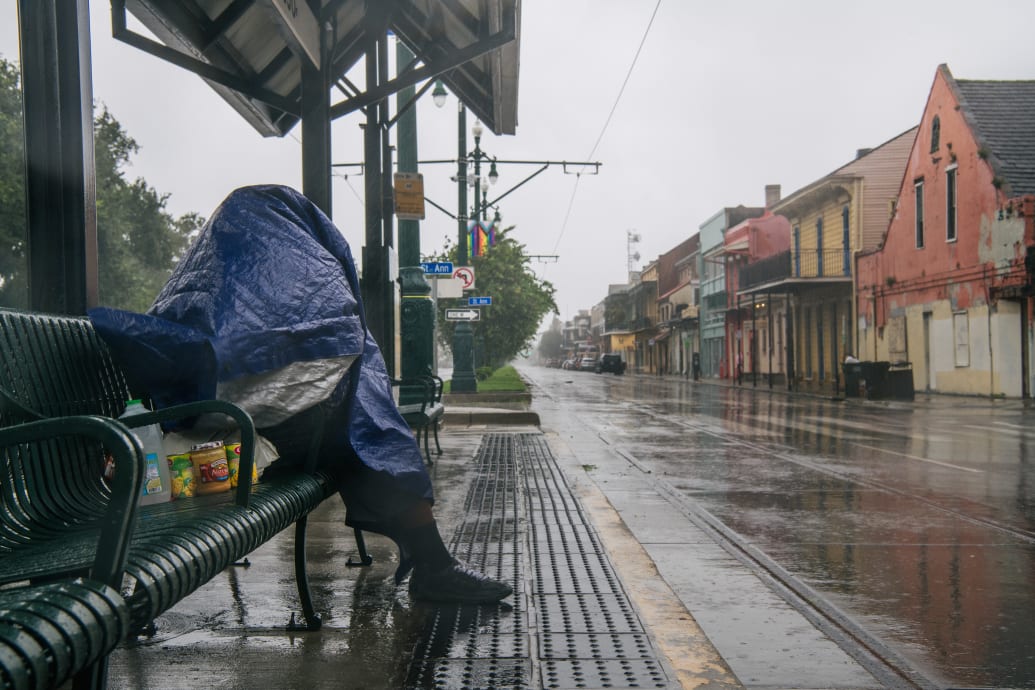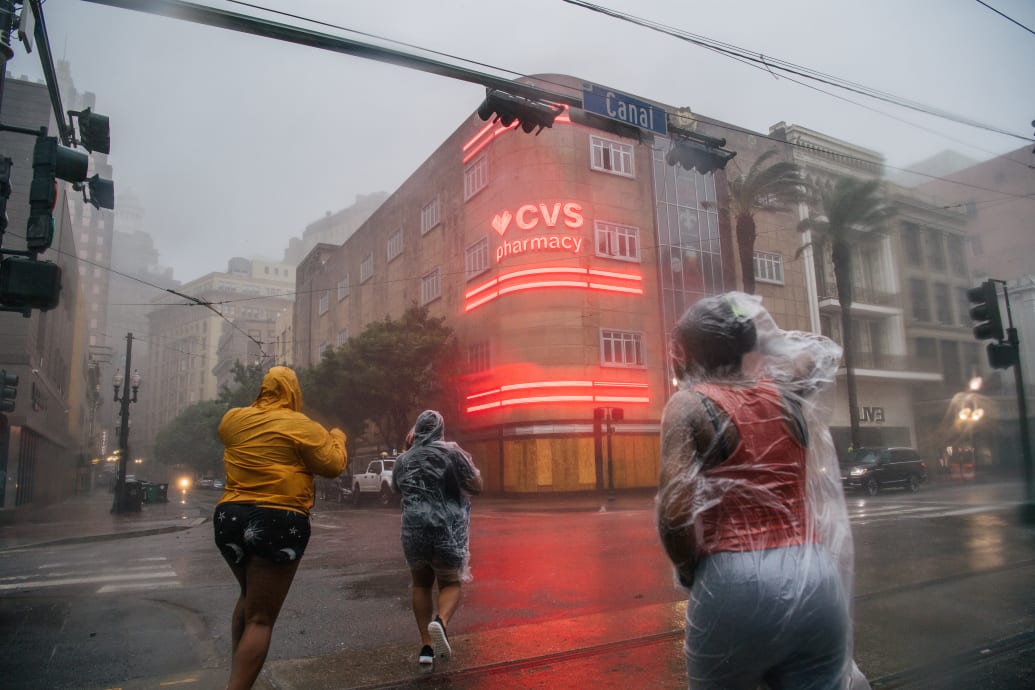LAFAYETTE, Louisiana—Hurricane Ida made landfall in Louisiana just before noon on Sunday, the anniversary of Hurricane Katrina, which killed more than 1,800 people in 2005.
By afternoon, the eye of the “extremely dangerous” Category 4 storm was over Port Fourchon with sustained wins of 150 mph, the National Hurricane Center reported.
Chett Chiasson, executive director at Port Fourchon, said he was confident that the facility would withstand the storm.
“Everything here is about as resilient as we can make it,” Chiasson said. “All of our structures are elevated. We have redundant generators for electricity. The buildings here are as ready for this sort of storm as we can make them.”
That engineering was tested over the next few hours as Ida threw all of her might against the port.
“We’re getting hit with it now,” Chiasson said. “We’re getting very high winds and very high water, but we are still in the midst of it.”
Port Fourchon is a multi-use coastal port that functions primarily as a land base for multiple offshore oil and gas support service companies. Chiasson said that the preparations for the possibility of a hit from Ida started last week.
“Hopefully, the wind and water comes down soon so we can see what damages we have,” Chiasson said. “We’ll persevere, because that’s what we do.”
This time around, that meant coping with the dual threat of the coronavirus pandemic still raging in the state. Louisiana has been a major national COVID-19 hot spot in recent weeks, and there was the danger that the storm might detract from pandemic relief—or that people taking shelter under duress might serve to stoke further outbreaks.
Some hospital systems were already showing signs of buckling under the strain: Just before 4 p.m., Thibodaux Regional Health System Hospital lost power due to issues with its emergency generator, requiring doctors and nurses on staff to manually force air into the lungs of COVID-19 patients when their ventilators no longer functioned.
According to Mindy Faciane, public information officer with the Louisiana Department of Health, the manual “bagging” of the patients was required while they were moved to areas of the hospital where power was available.
Faciane said she did not know how many patients were affected, or how long the manual bagging had to be maintained. Calls to the hospital’s media manager for more details have not yet been returned.
State Rep. Jerome Zeringue told NOLA.com that a doc on the scene described the situation as “Katrinaesque.”
The renewed ferocity of the pandemic in the Southeast more broadly served as the grim setting for a uniquely powerful storm.
According to Randall Mann, vice president for marketing and public relations at Acadian Ambulance, regular call volume dropped during the storm. “We’ve been lower on the non-hurricane calls,” Mann told The Daily Beast.
Still, he was optimistic the company was proving able to absorb that extra load while maintaining safety standards for its emergency personnel. “We’ve been conducting our normal transports and hurricane-related transports simultaneously,” Mann said. “We have shut down operations in various areas as wind speed increases and will resume again when it is safe.”
Mann said that the company suspends operation for its “box” units when the wind speed reaches 50 mph and at 45 mph for its lighter “Sprinter” vans.
Earlier in the day, the National Weather Service of New Orleans issued a series of warnings, including an ominous warning that they “can’t bear to see” the storm on satellite imagery.
“We have hard times ahead, but we will all persevere,” the service tweeted. “Take all messages we, public officials and broadcast media are saying SERIOUSLY. Stay tuned for more frequent updates.”
Warnings about Ida came as Hurricane Nora skimmed Mexico’s Pacific Coast towards the Gulf of California. Ida was expected to cause “catastrophic” damage, leaving the area where it makes landfall “uninhabitable for months.”
Tina Menard, 65, grew up on Grand Isle. Now a Lafayette resident, she and her nephew still own a fishing camp on the island and keep in touch with their friends there.
“They had a levee breach, so the water is five feet deep at the police station,” Menard said. “That’s in the middle of the island.”
Because so many people evacuated early, information from the island is spotty at best.
“I know that the chicken place across the street from the municipal multiplex survived several storms, but its roof blew off this time,” Menard said. “It’s been there since the 1970s. It survived everything, Katrina and all the other storms.”
She also said that the people on the island know that the storm was definitely a Category 4 at least when it rolled over the barrier island.
“The wind gauge at the police station broke at 140 mph,” Menard said.
Louisiana Gov. John Bel Edwards warned late Saturday, “This will be one of the strongest storms to hit Louisiana since at least the 1850s. Preparations need to be complete and you need to be where you intend to ride out the storm by tonight.”
As the storm made landfall, Elaine Leyda was watching her apartment building in the Carrollton River Bend neighborhood of New Orleans as rising winds hit the city.
“I can’t see my front yard except on the security cameras,” she explained. “I have a three-plex. Two tenants live in the front and my front door opens to the backyard. So I see the trees in the backyards of my block’s interior. And a huge camphor tree is getting much grief in these gusts.”
Just after Ida made landfall, Leyda was making tea on her electric range before the power went out entirely after making sure her car was parked in a safe place. By Sunday evening, at least half a million people were without power in Louisiana, as The New York Times reported.
“I moved my car into the neighbor’s driveway in case the street floods,” she said earlier Sunday. “Better to have a privacy fence land on it than for it to get flooded, I figure.”
For the most part, Leyda was finished with her preparations. She had considered evacuating, but stayed for the benefit of the tenants in her building. The storm, although still hours away from its peak in the Crescent City, was already making its presence known.
“There’s powerful gusts, and they’re becoming more frequent,” she said. “I have been hearing, the last four hours, very loud ‘BAMs,’ some of which could be transformers. But it’s clear that the storm has begun in earnest.”
At the same time, she is still a New Orleanian, which means she knows how to get by during long outages following storms like Ida, even without a gas stove.
“I had one in my other house, and I miss it at these times,” Leyda said. “But my cuz around the corner has gas, so after the storm I can go there and cook if I need to.”
As the day proceeded, she said, “The gusts are getting very scary now…. A few have rattled the house, and the buttonbush and hollies are hanging on. I think the big camphor may come down at some point.”
Source by www.thedailybeast.com
















































